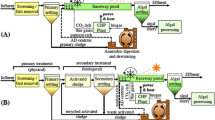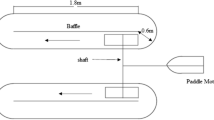Abstract
Salvinia minima combines several advantages for being used in aquatic phytoremediation. The objectives of this work were to compare the growth kinetics and productivity of S. minima and Spirodela polyrrhiza in high-strength synthetic organic wastewater (HSWW) and to evaluate the growth characteristics of S. minima in various culture media, including anaerobic effluents from pig wastewater (PWAE). It was found that the Relative Growth Rate (RGR) of S. minima was significantly higher (p < 0.05) compared to the RGR of S. polyrrhiza in Hutner Medium (HM) and in HSWW. Also, S. minima showed a 1.5 fold productivity and a 2.3 fold productivity, compared to S. polyrrhiza in HM and HSWW, respectively. Diauxic growth of S. minima was observed preferentially under pH control and there was a simultaneous consumption of two nitrogen sources. Productivity of S. minima was similar in pig waste anaerobic effluents (PWAE) and in HM without ammonium nitrate and amended with ammonium sulphate (MHM + AS), at an initial NH4 concentration of 35 mg l−1. Above this level, the productivity was found to decrease as the initial ammonium concentration increased, in both media. Growth was completely inhibited at 140 mg l−1 in the PWAE. In summary, S. minima is a better option than S. polyrrhiza for treating high-strength organic wastewater and lagoons should be operated at a maximum initial ammonium–nitrogen concentration of 70 mg l−1 and at a pH of 5.0 or 6.0. Likewise, the initial density should be maintained in the range of 7 to 15 g dw m−2.






Similar content being viewed by others
References
Agami, M., & Reddy, K. R. (1989). Inter-relationships between Salvinia rotundifolia and Spirodela polyrrhiza at various interaction stages. Journal of Aquatic Plant Management, 27, 96–102.
Amrane, A., Adour, L., & Couriol, C. (2005). An unstructured model for the diauxic growth of Penicillium camembertii on glucose and arginine. Biochemical Engineering Journal, 24, 125–133.
Aoi, T., & Hayashi, T. (1996). Nutrient removal by water lettuce (Pistia stratiotes). Water Science and Technology, 34, 7–8.
Beadle, C. L. (1993). Growth analysis. In D. O. Hall, J. M. O. Scurlock, H. R. Bolhàr-Nordenkampf, R. C. Leegood & S. P. Long (Eds.), Photosynthesis and production in a changing environment. A field and laboratory manual (pp. 36–46). London: Chapman & Hall.
Bello, P. (1997). Evaluación de la capacidad de remoción de nutrientes eutroficantes de Salvinia minima Baker en efluentes anaeróbicos de excretas porcinas (pp. 69). Xalapa, Ver: Universidad Veracruzana.
Bergmann, B. A., Cheng, J., Classen, J., & Stomp, A. M. (2000a). Nutrient removal from swine lagoon effluent by duckweed. Transactions of the American Society of Agricultural Engineers, 43, 263–269.
Bergmann, B. A., Cheng, J., Classen, J., & Stomp, A. M. (2000b). In vitro selection of duckweed geographical isolates for potential use in swine lagoon effluent renovation. Bioresource Technology, 73, 13–20.
Bonomo, L., Pastorelli, G., & Zambon, N. (1997). Advantages and limitations of duckweed-based wastewater treatment systems. Water Science and Technology, 35, 239–246.
Brandt, B. W., Kelpin, F. D. L., van Leeuwen, I. M. M., & Kooijman, S. A. L. M. (2004). Modelling microbial adaptation of changing availability of substrates. Water Research, 38, 1003–1013.
Caicedo, J. R., Van der Steen, N. P., Arce, O., & Gijzen, H. J. (2000). Effect of total ammonia nitrogen concentration and pH on growth rates of duckweed (Spirodela polyrrhiza). Water Research, 34, 3829–3835.
Clement, B., & Merlin, G. (1995). The contribution of ammonia and alkalinity to landfill leachate toxicity to duckweed. Science of the Total Environment, 170, 71–79.
Costa, M. L., Santos, M. C., & Carrapico, F. (1999). Biomass characterization of Azolla filiculoides grown in natural ecosystems and wastewater. Hydrobiologia, 415, 323–327.
Dickinson, M. B., & Miller, T. E. (1998). Competition among small, free-floating, aquatic plants. American Midland Naturalist, 140, 55–67.
Driever, S. M., van Nes, E. H., & Roijackers, R. M. M. (2005). Growth limitation of Lemna minor due to high plant density. Aquatic Botany, 81, 245–251.
El-Gendy, A. S., Biswas, N., & Bewtra, J. K. (2005). A floating aquatic system employing water hyacinth for municipal landfill leachate treatment:effect of leachate characteristics on the plant growth. Journal of the Environmental Engineering and Science, 4, 227–240.
Ferguson, A. R., & Bollard, E. G. (1969). Nitrogen metabolism of Spirodela oligorrhiza. 1. Utilization of ammonium, nitrate and nitrite. Planta, 88, 344–352.
Gijzen, H. J., & Veenstra,S. (2000). Duckweed-based wastewater treatment for rational resource recovery and reuse. In E. J. Olguin, G. Sánchez & E. Hérnandez (Eds.), Environmental biotechnology and cleaner bioprocesses (pp. 83–100). London: Taylor & Francis.
HACH (1995). Adapted from standard methods for the examination of water and wastewater 4500-NH3 B & C Company B and C.
Hernández, E., Olguín, E. J., Trujillo, S., & Vivanco, J. (1997). Recycling and treatment of anaerobic effluents from pig waste using Lemna sp. under temperate climatic conditions. In D. L.Wise (Ed.), Global environmental biotechnology (pp. 293–304). Amsterdam: Elsevier.
Huebert, D. B., McLarth, A. L., Shay, J. M., & Robinson, G. G. C. (1990). Axenic culture of Lemna trisulca. Aquatic Botany, 38, 295–301.
Korner, S., Vermaat, J. E., & Veenstra, S. (2003). The capacity of duckweed to treat wastewater: Ecological considerations for a sound design. Journal of Environmental Quality, 32, 1583–1590.
Kremling, A., Bettenbrock, K., Laube, B., Jahreis, K., Lengeler, J. W., & Gilles, E. D. (2001). The organization of metabolic reaction networks. III. Application for diauxic growth on glucose and lactose. Metabolic Engineering, 3, 362–379.
Lee, T. K., Lee, S. M., & Lee, W. S. (1999). Preferential use of acetate over glucose involves acetate-mediated inhibition of glucose uptake during diauxic growth of carrot cells. Plant and Cell Physiology, 40, 1046–1052.
Loehr, R. (1974). Agricultural waste management, problems, processes and approaches. New York: Academic.
Nakamura, Y., Sawada, T., & Inoue, E. (2001). Mathematical model for ethanol production from mixed sugars by Pichia stipitis. Journal of Chemical Technology and Biotechnology, 76, 586–592.
Olguín, E. J., Galicia, S., Mercado, G., & Pérez, T. (2003a). Annual productivity of Spirulina (Arthrospira) and nutrient removal in a pig wastewater recycling process under tropical conditions. Journal of Applied Phycology, 15, 249–257.
Olguin, E. J., Hernandez, E., & Ramos, I. (2002). The effect of both different light conditions and the pH value on the capacity of Salvinia minima BAKER for removing cadmium, lead and chromium. Acta Biotechnologica, 22, 121–131.
Olguín, E. J., Pérez-Pérez, T., & Pérez-Orozco, A. (2005a). Evaluation of Pb (II) removal by Salvinia minima and the role of green rhizospheric microalgae in continuous operated lagoons. In L. Yongding (Ed.), 10th International Conference on Applied Phycology. Kunming: China, July 24–30.
Olguin, E. J., Rodriguez, D., Sanchez, G., Hernandez, E., & Ramirez, M. E. (2003b). Productivity, protein content and nutrient removal from anaerobic effluents of coffee wastewater in Salvinia minima ponds, under subtropical conditions. Acta Biotechnologica, 23, 259–270.
Olguín, E. J., Sánchez-Galván, G., & Pérez-Pérez, T. (2004). Adsorption, accumulation and precipitation of lead in batch and continuous operated lagoons by Salvinia minima and rhizospheric microalgae. In A. Chakrabarty (Ed.), VII International Symposium on Environmental Biotechnology. Chicago, USA, June 18–21.
Olguin, E. J., Sanchez-Galvan, G., Perez-Perez, T., & Perez-Orozco, A. (2005b). Surface adsorption, intracellular accumulation and compartmentalization of Pb(II) in batch-operated lagoons with Salvinia minima as affected by environmental conditions, EDTA and nutrients. Journal of Industrial Microbiology & Biotechnology, 32, 577–586.
Oron, G., Porath, D., & Jansen, H. (1987). Performance of the duckweed species Lemna gibba on municipal wastewater for effluent renovation and protein production. Biotechnology and Bioengineering, 29, 258–268.
Oron, G., Wildschut, L. R., & Porath, D. (1984). Wastewater recycling by duckweed for protein production and effluent renovation. Water Science and Technology, 17, 803–817.
Porath, D., & Pollock, J. (1982). Ammonia stripping by duckweed and its feasibility in circulating aquaculture. Aquatic Botany, 13, 125–131.
Reddy, K. R., & Debusk, W. F. (1985). Growth characteristics of aquatic macrophytes cultured in nutrient-enriched water. II. Azolla, duckweed and Salvinia. Economic Botany, 39, 200–208.
Robarge, W. P., Edwards, P. A., & Johnson, B. (1983). Water and waste water analysis for nitrate via nitration of salicylic acid. Communications in Soil Science and Plant Analysis, 14, 1207–1215.
Vermaat, J. E., & Hanif, M. K. (1998). Performance of common duckweed species (Lemnaceae) and the waterfern Azolla filiculoides on different types of waste water. Water Research, 32, 2569–2576.
Whiteman, J. B., & Room, P. M. (1991). Temperatures lethal to Salvinia molesta MITCHEL. Aquatic Botany, 40, 27–35.
Acknowledgements
This work was financially supported by the National Council of Science and Technology (CONACYT) through two different grants: z-039 and P-46697-Z. Laura Escobar is kindly acknowledged for technical support.
Author information
Authors and Affiliations
Corresponding author
Rights and permissions
About this article
Cite this article
Olguín, E.J., Sánchez-Galván, G. & Pérez-Pérez, T. Assessment of the Phytoremediation Potential of Salvinia minima Baker Compared to Spirodela polyrrhiza in High-strength Organic Wastewater. Water Air Soil Pollut 181, 135–147 (2007). https://doi.org/10.1007/s11270-006-9285-9
Received:
Accepted:
Published:
Issue Date:
DOI: https://doi.org/10.1007/s11270-006-9285-9




